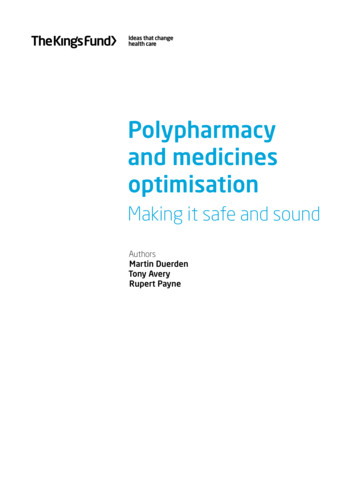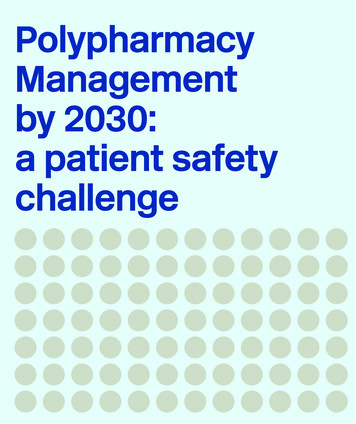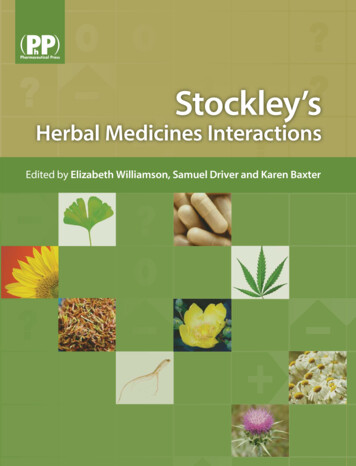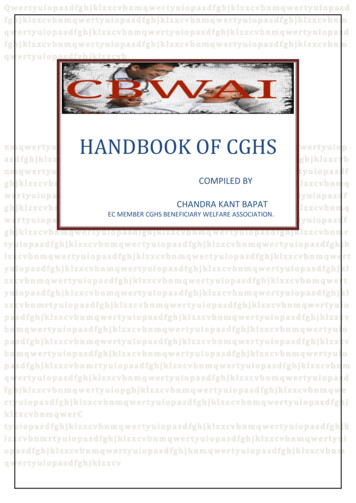
Transcription
Polypharmacyand medicinesoptimisationMaking it safe and soundAuthorsMartin DuerdenTony AveryRupert Payne
The King’s Fund is anindependent charity working toimprove health and health care inEngland. We help to shape policyand practice through researchand analysis; develop individuals,teams and organisations; promoteunderstanding of the health andsocial care system; and bringpeople together to learn, shareknowledge and debate. Our visionis that the best possible care isavailable to all.Published byThe King’s Fund11–13 Cavendish SquareLondon W1G 0ANTel: 020 7307 2591Fax: 020 7307 2801www.kingsfund.org.uk The King’s Fund 2013First published 2013 by The King’s FundCharity registration number: 1126980All rights reserved, including the right of reproduction in whole or in part inany formISBN: 978 1 909029 18 7A catalogue record for this publication is available from the British LibraryAvailable from:The King’s Fund11–13 Cavendish SquareLondon W1G 0ANTel: 020 7307 2591Fax: 020 7307 2801Email: publicationsEdited by Anna BrownTypeset by Peter Powell Origination & Print LimitedPrinted in the UK by The King’s Fund
ContentsList of tables and figuresivAbout the authors and acknowledgementsvForewordviiKey pointsixIntroduction112What is polypharmacy?Why polypharmacy is an important challenge12‘Measuring’ polypharmacy5Defining polypharmacy according to numbers of medicinesTools to assess appropriateness of prescribing in polypharmacyProposed pragmatic approach for identifying higher-risk polypharmacy557The epidemiology of polypharmacy9Polypharmacy in primary carePolypharmacy in hospitalsMedication use in care homesPolypharmacy in other countriesMulti-morbidity and ageing as driving factors3Medicines optimisation and polypharmacyEvidence for improving medicines management in polypharmacyReducing medication errorsPolypharmacy and use of monitored dose systemsMedication review and repeat prescribingPolypharmacy at discharge and medicines reconciliationSuggestions for improving care in the context of multi-morbidityMedicines management in care homesPolypharmacy and stopping medicinesMedication waste, medicines management and polypharmacy4517171919202122232425Evidence-based polypharmacy27Prescribing and polypharmacy in older people29Are drugs for older people effective?Medication reviews, polypharmacy and older people29306Polypharmacy and the patient experience327Summary338Case examples and practical tips349Resources39Referencesiii91011111349 The King’s Fund 2013
List of tables and figuresTablesTable 1Table 2Table 3Table 4Prescribing indicators used to identify problematic or inappropriate polypharmacyYear-on-year change for drugs used to treat diabetes, England, 2005/6 to 2011/12Reducing relative and absolute risk through polypharmacyThe Hypertension in the Very Elderly Trial (HYVET)6142730Prescription items dispensed per head of population in UK countries, 2011/12Trends in prescription items dispensed, England, 2001 to 2011Multiple drug use, Scotland, 1995 and 2010Polypharmacy, Sweden, 2005 to 2008Number of chronic disorders by age groupEstimated and projected age structure, UK population, mid-2010 and mid-2035Estimated and projected population aged 85 and over, United Kingdom, 2010and 2035Selected co-morbidities in people with coronary heart disease, diabetes, COPDor cancer in the most affluent and most deprived areas of Scotland233121415FiguresFigure 1Figure 2Figure 3Figure 4Figure 5Figure 6Figure 7Figure 8iv1616 The King’s Fund 2013
About the authors andacknowledgementsMartin Duerden has worked as a part-time GP in Conwy, North Wales since1999. In2003 he became Medical Director at Conwy Local Health Board, reorganised to BetsiCadwaladr University Health Board (BCUHB) in 2009. He now works as Deputy MedicalDirector for BCUHB, which covers all hospital and primary care services for NorthWales. He is also a clinical senior lecturer at Bangor University.Martin qualified at Newcastle University and was a full-time GP in the north-east ofEngland for eight years until 1994. He worked for several years as medical adviser to EastNorfolk Health Authority and then trained in public health medicine in Cambridge.For three years he worked as Medical Director for the National Prescribing Centre forEngland, based in Liverpool. Following this, from 2001, he worked on various projects:as a medicines management consultant in University College London Hospitals Trust; onthe PRODIGY project on decision support for general practice; and at Keele University.He is on the editorial board of Prescriber and on the paediatric formulary committee forthe BNF for Children. He sits on a NICE Technology Appraisal Committee and NICEClinical Guideline Group. He organised the Diploma in Therapeutics at Cardiff Universitybetween 2005 and 2010. He was co-author of The King’s Fund report on the quality ofGP prescribing. He is a clinical adviser to the Royal College of General Practitioners onprescribing and on evidence-based medicine.Tony Avery is Professor of Primary Health Care, School of Medicine, University ofNottingham, and a part-time GP in Chilwell, Nottingham.Tony qualified in medicine from the University of Sheffield and has been a clinicalacademic at the University of Nottingham since 1992.He has a longstanding interest in prescribing and patient safety and has led a numberof large studies investigating the prevalence and causes of prescribing errors, andidentifying effective methods for improving patient safety.He is Consultant Editor of the journal Prescriber and a member of the Primary CareSafety Board of NHS England. He was Chair of the UK Drug Utilisation ResearchGroup 2003-2006; a Member of the Joint Formulary Committee of the British NationalFormulary 2006 – 2012, and co-author of The King’s Fund Report on the quality ofGP prescribing.Rupert Payne is Clinical Lecturer in General Practice, University of Cambridge, andHonorary Consultant, Clinical Pharmacology Unit, Addenbrooke’s Hospital, Cambridge.Rupert trained in Edinburgh in both general practice and clinical pharmacology andtherapeutics. Since 2010 he has held a NIHR Clinical Lectureship in General Practice atthe University of Cambridge, based in the Cambridge Centre for Health Services Research.His research interests centre on polypharmacy, multimorbidity and quality of prescribingin the primary care setting, with a particular focus on cardiovascular disease. Hecontinues to have a part-time clinical role, based both in primary and secondary care.v The King’s Fund 2013
Polypharmacy and medicines optimisation He has previously held an honorary contract with the Information Services Division ofNHS Scotland working on pharmacoepidemiology, and was involved in evaluation ofthe advisory work of the Scottish Medicines Consortium. He is a member of the BritishPharmacological Society and Royal College of Physicians of Edinburgh, is a ClinicalAdviser for the Royal College of General Practitioners, Honorary Fellow of The Universityof Edinburgh, and an associate editor for BMC Family Practice.AcknowledgementsWe would like to thank the people who attended The King’s Fund seminar onpolypharmacy held on 23 January 2013 who helped to identify and develop some of theideas and suggestions discussed in this report.vi The King’s Fund 2013
ForewordMedical advances offer the hope of bringing benefits to patients but also have thepotential to do harm if not used appropriately. Knowing when and how to treat patients isparticularly important in the prescribing of drugs as populations age and multi-morbiditybecomes more prevalent. The challenge for clinicians is keeping up to date with newdrugs as they come on the market and being aware of the interaction between them inpatients being treated for a number of medical conditions.In an analysis of more than 300,000 patients, a Scottish study found that the meannumber of drugs dispensed increased from 3.3 in 1995 to 4.4 in 2010. As the authors ofthis paper explain, this meant that the proportion of patients receiving 5 or more drugsincreased from 12 to 22 per cent, and the proportion of patients receiving 10 or moredrugs increased from 1.9 to 5.8 per cent. This matters because unless the drugs prescribedto patients are reviewed regularly by clinicians with up-to-date knowledge there is a riskthat treatment may be ineffective at best and harmful at worst.A desire to increase awareness of the importance of polypharmacy prompted The King’sFund to commission this paper with the aim of bringing together what is known aboutthis topic and to identify the implications for policy and practice. The Fund’s interestderives from work on the care of people with long-term conditions and how this canbe improved. Our brief to the authors was to review the evidence on polypharmacyand particularly to highlight how to optimise the contribution that medicines make toenabling informed patient choice and delivering desired outcomes for patients.The authors have responded to this brief by producing a paper that brings together datafrom a variety of sources to scope the issues involved and to outline some potentialsolutions. The paper makes clear that action is needed on several fronts, and must involvepatients, doctors, nurses and pharmacists. Avoiding the risks of polypharmacy requireseffective team working between clinicians, and in hospitals they argue that there is a rolefor a generalist clinician able to coordinate the care of patients with complex needs.In general practice, consultations with patients with multi-morbidity need to be longerto allow sufficient time for the use of drugs to be reviewed. There is also a strong case forreviewing the way in which the quality and outcomes framework focuses on improvingthe treatment of single diseases rather than the needs of patients with a number of longterm conditions. Although polypharmacy is not exclusively an issue that affects olderpeople, it is particularly important that medication reviews are undertaken regularly forthis age group to support scaling back or indeed increasing treatment where appropriate.It goes without saying that understanding the patient perspective on polypharmacy isessential, not least because patients may not be taking the drugs that clinicians thinkthey are. The practical challenges for some patients of managing their use of multiplemedications are well established, adding to the complexity of implementing appropriateprescribing. Although a variety of ways have been developed to help patients deal withthis complexity, much more can be done to involve patients as partners in their care, withcarers and families engaged where relevant.vii The King’s Fund 2013
Polypharmacy and medicines optimisationIn publishing this paper, the Fund hopes both to raise awareness of these issues and tooffer practical guidance to clinicians and others in avoiding what the authors describe as‘problematic polypharmacy’. We are grateful to the authors for shining a light on an areaof care that deserves more attention.Chris HamChief Executive, The King’s Fundviii The King’s Fund 2013
Key pointsDescribing and defining polypharmacy Polypharmacy is an expression that has been commonly used for many years inmedicine. It is generally understood as referring to the concurrent use of multiplemedication items by one individual.The term has been used both positively and negatively. In the past polypharmacyhas been considered something to be avoided. It is now accepted that in manycircumstances polypharmacy can be therapeutically beneficial.In this report, we propose the terms ‘appropriate polypharmacy’ and ‘problematicpolypharmacy’. This recognises that polypharmacy has the potential to be beneficialfor some patients, but also harmful if poorly managed.Appropriate polypharmacy is defined as prescribing for an individual for complexconditions or for multiple conditions in circumstances where medicines use has beenoptimised and where the medicines are prescribed according to best evidence.Problematic polypharmacy is defined as the prescribing of multiple medicationsinappropriately, or where the intended benefit of the medication is not realised.Polypharmacy may be harmful in that it can increase the risk of drug interactionsand adverse drug reactions, together with impairing medication adherence andquality of life for patients.On the other hand, employing many appropriate treatments can theoreticallyimprove outcomes for patients, especially given that there is an increasing evidencebase for many drug interventions. However, the evidence base for multipleinterventions for several conditions in an individual patient is poor.Polypharmacy is widespread and increasingly common, occurring in primary andsecondary care, and in care homes for older people. It has become a global issue,particularly, although not exclusively, in Western countries.It is driven by the growth of an ageing (and increasingly frail) population and by theincreasing prevalence of multi-morbidity (where patients may be living with severallong-term conditions, often compounded by disability and/or frailty).Evidence-based treatment and guidelines ixFor many people, appropriate polypharmacy will extend life expectancy and improvetheir quality of life. Where there is no evidence of benefit from the drugs beingprescribed, polypharmacy should be avoided. The King’s Fund 2013
Polypharmacy and medicines optimisation The evidence for choosing treatment where there is polypharmacy should ideallybe clearly stated. Prescribers should record the rationale for non-evidence-basedprescriptions, for example, through patient choice.Many clinical trials and practice guidelines do not consider polypharmacy in thecontext of multi-morbidity. A single-disease framework prevails in most health caresystems, medical research and medical education.It is important that pragmatic clinical trials are conducted that include patients withmulti-morbidity and polypharmacy.Guidelines should be developed that take account of long-term conditions thatcommonly co-exist, such as diabetes, coronary heart disease, heart failure andchronic obstructive pulmonary disease.A pragmatic approach to identifying higher-risk polypharmacy in practice is tofocus on patients at particularly high risk: for example, those receiving 10 or moreregular medicines, or those receiving 4 to 9 regular medicines together with otherunfavourable factors (examples include: a contraindicated drug; where there ispotential for drug–drug interaction; or where medicine taking has proved a problemin the past).Implications of polypharmacy on clinical services and policy Multi-morbidity and polypharmacy increase clinical workload. Doctors, nurses andpharmacists need to work coherently as a team, with a carefully balanced clinicalskill-mix.There should be more training in managing complex multi-morbidity, polypharmacyand other aspects of medicines management. This could include general practitioners(GPs), clinicians who specialise in care of older people, orthogeriatricians, clinicalpharmacologists, nurse specialists and clinical pharmacists.Rather than attending several disease-specific clinics, patients could have all theirlong-term conditions reviewed in one visit by a clinical team responsible for coordinating their care. Patients with multi-morbidity admitted to hospital under onespecialty may require access to a generalist clinician to co-ordinate their overall care.There is a need to develop systems that optimise medicines use where there ispolypharmacy so that people gain maximum benefit from their medication with theleast harm and waste. This may include training programmes, improved electronicdecision support for clinicians and/or patients, patient-friendly information systems,judicious use of monitored dose systems and clinical audit.Implications for clinical practice xPrescribers may not recognise that symptoms could be iatrogenic and unwittinglyprescribe new medication to counter the adverse effects of other drugs. This is knownas incremental prescribing or the ‘prescribing cascade’ and should be avoided.Prescribers should consider whether interactions between drugs where medicationis combined will undermine therapeutic benefit.Many people stay on medicines beyond the point where they are deriving optimalbenefit from an intervention. When reviewing medications, health care professionalsshould consider if treatment can be stopped and recognise that ‘end-of-life’considerations apply to many chronic diseases as well as cancer-related conditions. The King’s Fund 2013
Key points xiPeople often do not take medicines in the way that prescribers intend and there isconsiderable evidence that many dispensed medicines remain unused or are wasted.These problems increase as drug regimens become more complex.The patient perspective on medicine-taking needs to be determined. Compromise maybe needed between the view of the prescriber and the patient’s informed choice. The King’s Fund 2013
We dislike polypharmacy as much as it is possible, and we would never exhibit a remedyof any kind unless we had a scientific reason for so doing and unless we were prepared todefend our method of treatment.W Newnham, Provincial Medical and Surgical Journal, 1848
IntroductionWhat is polypharmacy?In simple terms polypharmacy is the prescribing of multiple items to one individual.Usually this relates to medication use, but in the United Kingdom NHS prescriptionsare also used for dressings, appliances and sometimes blood-testing equipment ornutritional preparations. This report concentrates on the prescribing of medication.There has been no consensus on whether polypharmacy applies only to simultaneousprescribing of several drugs at a time, or if it applies to short-term as well as long-termmedication. Often the term polypharmacy implies criticism of the way several medicineshave been prescribed but sometimes it is necessary for patients to be taking largenumbers of medicines. This report proposes a classification based on prescribing multiplemedications where the treatment may be either appropriate or problematic.Appropriate polypharmacy is prescribing for an individual for complex conditionsor for multiple conditions in circumstances where medicines use has been optimisedand the medicines are prescribed according to best evidence. The overall intent for thecombination of medicines prescribed should be to maintain good quality of life, improvelongevity and minimise harm from drugs.Problematic polypharmacy is where multiple medications are prescribed inappropriately,or where the intended benefit of the medication is not realised. The reasons whyprescribing may be problematic may be that the treatments are not evidence-based, or therisk of harm from treatments is likely to outweigh benefit, or where one or more of thefollowing apply: the drug combination is hazardous because of interactionsthe overall demands of medicine-taking, or ‘pill burden’, are unacceptable tothe patientthese demands make it difficult to achieve clinically useful medication adherence(reducing the ‘pill burden’ to the most essential medicines is likely to bemore beneficial)medicines are being prescribed to treat the side effects of other medicines wherealternative solutions are available to reduce the number of medicines prescribed.Measures of polypharmacy are often used to assist assessment of higher risk and to guideaudits. For example, some studies have looked at the concurrent prescribing of five ormore medicines as a threshold to identify people selected for medication review. Giventhe growth in prescribing, such a threshold may now be too low.Patient involvement in decisions on drug use is fundamental in prescribing andparticularly in polypharmacy. Patients may not want to take multiple medicines, or preferone treatment over another. Advice should be given on which interventions may be mostlikely to minimise side effects, reduce symptoms and improve outcomes. Regimens may1 The King’s Fund 2013
Polypharmacy and medicines optimisationneed to be tailored to fit with patient preferences and ‘compromise’ may be required.Polypharmacy is likely to be futile if medicines are not taken as the prescriber intends.Medicines optimisation, or robust medicines management, helps to ensure moreappropriate polypharmacy so that the various trade-offs of harm, benefit and patientacceptability and choice have been considered and an explicit decision on the drug to usehas been made with the patient.Why polypharmacy is an important challengePolypharmacy is becoming increasingly common. In the past decade, the average numberof items prescribed for each person per year in England has increased by 53.8 per cent,from 11.9 (in 2001) to 18.3 (in 2011) (NHS Information Centre 2012) (see Figure 1 belowand 2, opposite). A large Scottish study has confirmed the considerable and increasingprevalence of polypharmacy: 12 per cent of patients were dispensed 5 or more drugs in1995, rising to 22 per cent in 2010; and 1.9 per cent of patients were dispensed 10 or moredrugs in 1995, rising to 5.8 per cent in 2010 (Figure 3, opposite).Items dispensed (millions) per head of populationFigure 1 Prescription items dispensed per head of population in UK countries, rthern IrelandWalesNote: These figures are based on dispensing in the community and do not include hospital-initiatedprescriptions. These are not the numbers of specific drugs prescribed per patient; for example, if a patientreceives the same drug each month on a repeat prescription this would count as 12 items.Source: Statistics for Wales (2012)There are several explanations for this rise. Asymptomatic people are increasingly treatedwith preventive interventions to reduce their future risk of mortality and disease. Thisis seen particularly with cardiovascular disease and medicines to reduce stroke andacute myocardial infarction events. Many ‘well’ people are being prescribed complicatedpreventive drug regimens, and as a result they are being put at risk of adverse eventsand harm from drug interaction. The population is also ageing and the prevalence ofchronic disease increasing. Already, many patients have several co-morbidities. If eachone of these is treated according to national guidelines, patients may end up taking acomplicated cocktail of drugs.2 The King’s Fund 2013
Figure 2 Trends in prescription items dispensed, England, 2001 to 20118020032004200520062007YearAnalgesicsNumber of prescription items ticosteroids (respiratory)2001Lipid-regulating rugs used in diabetesNote: This graph shows items dispensed for the five British National Formulary sections that had the greatestnet ingredient cost in 2011.Source: NHS Information Centre (2012) 1AnalgesicsFigure 3 Multiple drug use, Scotland, 1995 and 2010AntiepilepticsCorticosteroids (respiratory)Lipid-regulating drugs60Drugs used in diabetes1995Year 1 drug 5 drugsPercentage of patients on multiple drugs002Introduction50201040302010019952010Year 10 drugsSource: Guthrie and Makubate (2012)21 2013. Re-used with the permission of the Health and Social Care Information Centre. All rights reserved.2 Reproduced from Primary Health Care Research and Deveopment, vol 13, suppl S1:45, (2012) with permission fromCambridge University Press.3 The King’s Fund 2013
Polypharmacy and medicines optimisationAdverse reactions to medicines are implicated in up to 6.5 per cent of hospital admissions.Patients admitted with one drug side effect are more than twice as likely to be admittedwith another (Pirmohamed et al 2004). Patients on multiple medications are more likelyto suffer drug side effects; this is related more to the number of co-morbidities a patienthas than to the patient’s age (Pirmohamed et al 2004).Patients are often prescribed (and may remain on) drugs that cause adverse effects and wherethe harm of the drug outweighs the benefit (Guthrie et al 2011). It is also recognised thatpeople who once derived benefit from prescribed drugs may not continue to do so but theirtreatments are not always stopped once this point is reached. For example, polypharmacy maybe a particular problem in people with multiple morbidities and limited life expectancy as theymay gain little further benefit from treatments aimed at preventing future disease.It is worth considering clinical guidelines in relation to multi-morbidity and comorbidity. Multi-morbidity is generally considered to be the presence of more thanone long-term condition; a co-morbidity is a long-term condition that exists in thepresence of another long-term condition. Guidelines are often based on evidence fromstudies of patients with single conditions and guideline developers do not take intoaccount patients with multi-morbidity (Guthrie et al 2012a; Hughes et al 2013) to whomgeneral principles may not apply (Masoudi et al 2003; Travers 2007; Van Spall et al 2007;Saunders et al 2013). Such guidelines rarely modify or discuss the applicability of theirrecommendations for patients with multiple co-morbidities or for older patients; nor dothey take account of patient preferences. They may also fail to comment on the qualityof the evidence underpinning the guideline (Boyd et al 2005). Furthermore, guidelinesoften fail to acknowledge the potential problems of multiple medicines use. Use of clinicalguidelines may therefore inadvertently promote problematic polypharmacy and increasethe risk of adverse events such as drug–drug and drug–disease interactions. Falls andother complications such as urinary incontinence are well-recognised adverse effects inolder or frail people that may not have been considered during guideline development.For many patients polypharmacy might be entirely appropriate (Aronson 2004). Thereare many conditions in which the combined use of two, three or more drugs is beneficialand can improve outcomes especially in older people with multiple co-morbidities (forexample, type 2 diabetes complicated by coronary heart disease and hypertension).However, it is important to consider whether each drug has been prescribed appropriatelyor inappropriately, both individually and in the context of all the drugs being prescribed(Aronson 2006). Optimising prescribing in polypharmacy involves encouraging the useof appropriate drugs, in a way that the patient is willing and able to comply with, to treatthe right diseases. In certain circumstances, this may include the removal of unnecessarydrugs, those that the patient feels unable to take or comply with, or those with no validclinical indication, as well as the addition of useful ones.Under-prescribing in older people has also gained recognition as a concern. Paradoxically insome cases, drugs that are recommended for some conditions are actually not prescribed bydoctors because of fears of causing polypharmacy-related problems in the patient. There canbe a reluctance to prescribe additional drugs to patients with polypharmacy due to a perceivedcomplexity of drug regimens, fear of adverse drug reactions, and concerns about drug–druginteractions or poor adherence (Kuijpers et al 2007). It may be that those at highest risk forcomplications have the lowest probability of receiving recommended medications.In summary, polypharmacy can refer to the prescribing of many drugs appropriatelyor too many drugs problematically. What constitutes ‘too many’ drugs is a prescribingdilemma, and choosing the best interventions aimed at ensuring appropriatepolypharmacy is a challenge for all prescribers and health care organisations, butparticularly in general practice (Payne and Avery 2011). Prescribing should be done in away that explicitly considers the overall effects of the total drug regimen.4 The King’s Fund 2013
1 ‘Measuring’ polypharmacyDefining polypharmacy according to numbers of medicinesThe term polypharmacy does not in itself imply whether it is appropriate to prescribeseveral medications, although it is often assumed that it is inappropriate to do so. This isreflected in the two most common approaches used to define or measure polypharmacyin the literature: the use of a specific threshold for the number of drugs, or alternativelya measure of the number of inappropriate drugs or combinations of drugs according topre-defined criteria.The use of a specific numeric threshold is widespread in the literature. It has theadvantage of being simple and easily identified in clinical practice. Often these thresholdsare arbitrarily chosen, with more than three or four medicines commonly used as the cutoff value. Since the number of drugs that patients receive has been rising in recent years,it is possible that the utility of a specific threshold may change over time. For example,four or more drugs was considered high a decade ago, but this is now commonplace anda threshold of ten or more might be more appropriate. This could potentially providegreater specificity for problematic prescribing and offer a more pragmatic means ofidentifying those patients most in need of medication reviews. However, these patientsmay not be readily identified by general practice computer systems. There is evidence thatwhen polypharmacy is defined through use of a threshold it is associated with adverseoutcomes (Jyrkka et al 2009; Cherubini et al 2012). Such definitions are used in admissionprediction models where the prescribing of a certain number of drugs can be included asa predictive factor for hospitalisation (Wennberg et al 2006). There is also clear evidenceof an increasing risk of prescribing errors, high-risk prescribing and adverse drug eventsthe greater the number of drugs prescribed (Bourgeois et al 2010; Guthrie et al 2011),with ten or more drugs c
Medication review and repeat prescribing 20 Polypharmacy at discharge and medicines reconciliation 21 Suggestions for improving care in the context of multi-morbidity 22 Medicines management in care homes 23 Polypharmacy and stopping medicines 24 Medication waste, medicines management and polypharmacy 25 4 Evidence-based polypharmacy 27










